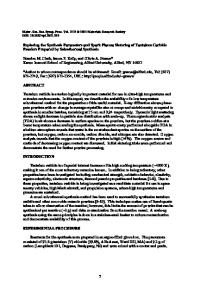Synthesis of NiTi by Low Electrothermal Loss Spark Plasma Sintering
- PDF / 332,020 Bytes
- 8 Pages / 593.972 x 792 pts Page_size
- 16 Downloads / 349 Views
ON
DURING the last two decades, shape memory alloys (SMAs) have been extensively studied because of their promising properties and potential applications.[1–3] Particular attention has been given to NiTi alloys because of their mechanical and some other properties,[1] such as excellent shape memory effect (SME), super elasticity behavior, good corrosion resistance, high damping capacity,[4,5] as well as high biocompatibility with natural biomaterials such as bones, making them attractive materials for bioapplications.[6] These properties make NiTi alloys among the most commercially used SMAs for various technologies,[3,5,7] as well as medical applications.[3,8] There are several approaches to produce NiTi alloys such as casting,[9] metallic deposition,[10] and powder metallurgy.[11] Powder metallurgy, for reasons such as the possible use of both prealloyed and elemental powders and relatively good final homogeneity and densification, constitutes one of the most promising methods and includes various techniques such as conventional sintering,[12,13] selfpropagating high-temperature synthesis,[14] hot isostatic pressing (HIP),[10,15] and field-activated pressure-assisted synthesis, which in the literature is generally known as spark plasma sintering (SPS).[16] During the conventional SPS process, the starting powder is comG. MAJKIC, Research Assistant Professor, N. CHENNOUFI, Doctoral Student, and Y.C. CHEN and K. SALAMA, Professor, are with the Department of Mechanical Engineering, University of Houston, Houston, TX 77204-4006. Contact e-mail: [email protected] Manuscript submitted January 12, 2007. Article published online September 13, 2007. METALLURGICAL AND MATERIALS TRANSACTIONS A
pacted and uniaxially stressed in a graphite die via graphite plungers, after which a high current density in the form of pulsed current is passed through the sample and the graphite die. Joule heating is then responsible for the activation of diffusion processes leading to sample compaction and densification. The effect of pulsing is generally reported in the literature to be responsible for formation of sparks and subsequent formation of plasma that aids the sintering process. It has been demonstrated, however, that the current pulsing has no observable effect on densification and homogenization rate compared to direct current, rendering the term SPS questionable.[17] On the other hand, it has been demonstrated that the presence of high current density (direct current) has a profound effect on the densification rate in Ni-Ti,[18] Au-Al,[19] and AgZn,[20] resulting in a drastic increase in homogenization rate by interdiffusion. The mechanism behind this effect has not been fully elucidated yet. However, Munir et al. have shown that this effect is not due to electromigration.[16,19] All of the SPS studies known to the authors used a graphite die and plunger combination. It should be noted that, in general, this configuration results in a large fraction of the total current being conducted through the graphite die instead of the sample itself. This signific
Data Loading...











